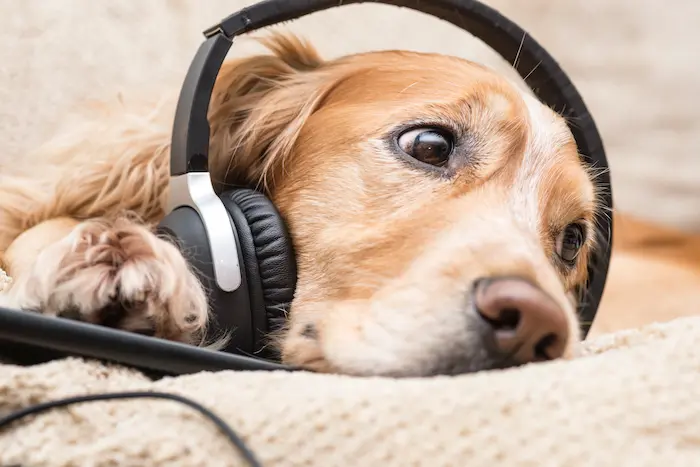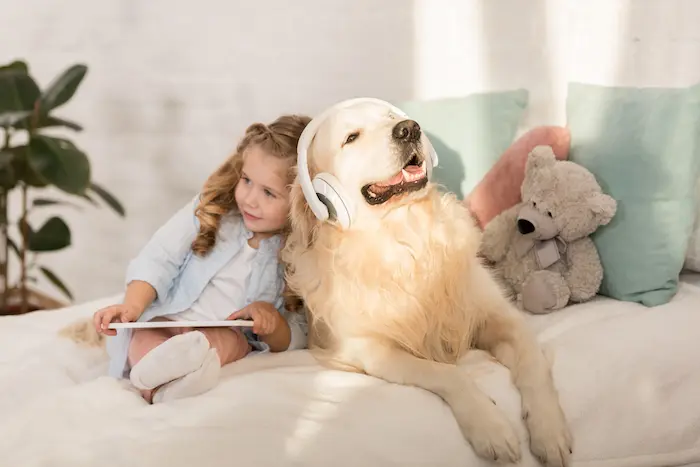
If you enjoy listening to calming sounds to unwind after a stressful day, it might not surprise you that dogs can benefit from calming music too. Some studies have shown that music can help dogs suffering from anxiety disorders or in stressful situations.
Picking the right soothing music and offering variety is key. Even though music calms dogs, they can quickly become bored when listening to the same tunes, and the music loses its positive effects.
This guide reviews some tips for dog owners looking for ways to calm an anxious dog without using medication. Soothing music is one of many tools you can use to keep pets in your household happy and relieve separation anxiety when you need to leave.
Classical Music May Calm Anxious Dogs
Many animals respond well to classical music. Cats and dogs experiencing elevated stress levels often relax when they can listen to classical music compared to certain other types of music. You can easily turn to YouTube if you want a soothing classical number to play for your dog. Try pieces that include solo piano or a calm variety of tempos, and don’t play the same tune on repeat or your dog will lose interest.
Studies found that calming music for dogs varied greatly based on the dog’s initial mood and surroundings. Classical music is most useful if your dog is already stressed. If you’re expecting a thunderstorm, leaving a dog with separation anxiety alone or trying to mask city sounds that frequently disturb your dog, playing music with classical instruments has the greatest impact.
Relaxing Music Can Help You Crate Train Your Dog
Crate training can help puppies acclimate to your home, teach them where to do their business and give them a den to retreat to when they want to feel safe. One of the issues many people have when crate training a puppy is creating a positive association with the crate. You shouldn’t use crate time as punishment or your dog won’t want to spend time in its crate.
If you play soft rock or reggae music while your dog is inside the crate, it can calm it and make it feel happy. Choosing calming rhythms and melodies can help your dog sleep better in its crate. Pay attention to how your dog reacts to different frequencies to see which songs are most soothing.
Music Can Distract Dogs From Other Sounds
The sound of fireworks, thunder or car backfires can send your dog running beneath the bed or couch. Some dogs can’t tolerate loud noises, but you can use music to distract them when you’re anticipating a storm or people are making more noise outside. Using TV or music for dogs keeps the dog’s ear focused on what’s present instead of sounds coming from outside.
Dogs Enjoy Musical Variety Just Like Humans
If you’ve been annoyed at a radio station for playing the same song too many times, you might’ve changed stations or opted to use a music service that gives you more control over what you listen to. Dogs and cats are interested in music, but they tune out repetitive sounds when they become redundant or annoying. The studies above, which proved calming music influenced dogs, also showed that they quickly lost interest unless they had musical variety.
How to Choose the Best Music for Your Dog

Dogs respond to music like we do. They may have personal preferences just as humans do when choosing certain kinds of music. Just as our moods influence what type of music we like to listen to, dogs may respond to music differently based on their feelings. If they’re feeling fear and anxiety, they might need a different music selection than when you’re trying to get them to relax and go to sleep.
Start playing music and watch how your dog reacts. Calm dogs display submissive body language. Their ears might drop, they might curl up on the couch and they might act more affectionate. These are signs your dog may be enjoying the music.
If your dog seems alert, their ears are up and they’re scanning the room, they’re not paying much attention to the music. They could be experiencing anxiety or hearing something outside they’re more interested in.
How a Puppy Responds to Different Tones
Dogs communicate through sound and body language. When you train a puppy, it learns to detect emotions and consequences through your voice. A deeper, stern tone can communicate that the animal has done something wrong, and a high-pitched tone can communicate reward and celebration. When you’re scanning the internet for music programs for dogs, listen to the songs and predict how the musical tones and frequencies could influence your dog.
Low, menacing tones could create disharmony and put your dog off the experience, while slow to mid-tempo tunes with higher tones may soothe it more easily. Avoid compositions that are too quick or percussive, as the tone and tempo might heighten your dog’s awareness or put it in an energetic mood.
How Understanding Dogs’ Reactions to Music Can Help You Train Your Dog
You can use sound for much more than treating fear or anxiety. While it can calm your dog, sound may also alert it when it’s doing things it shouldn’t. Using training collars such as the Halo Collar allows you to communicate with your dog through sound and sensations, so it knows where it’s allowed to roam.
Features include a wide range of sound, vibration or static stimuli that guide your dog to remain within an area you set in the app. You can create up to 20 invisible fences and see where your dog is in real-time. If your dog drifts to the boundary’s edge, the collar deters it from leaving the spot and brings it back inside the desired area with a dog-whistling function.
At Halo Collar, your dog’s safety is our priority. After you train your dog to respond to our collar, you can place a virtual fence anywhere you go so your dog doesn’t wander somewhere unsafe. The included training materials allow you to build a more trusting and bonded relationship with your dog too. Find the right GPS dog collar for your dog today.






